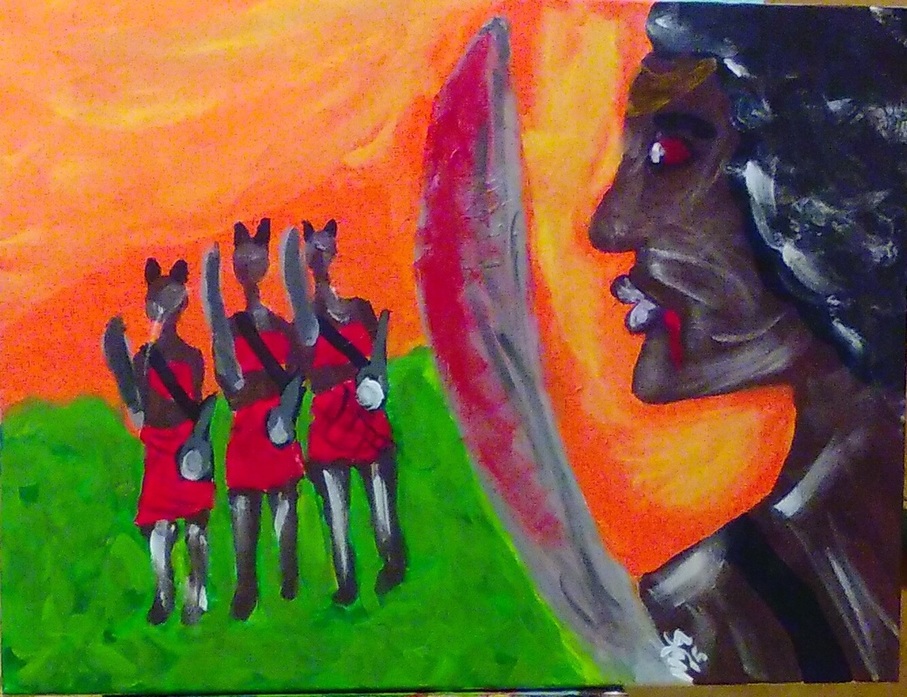Niomi Gibson
Click Here to Inquire About Collecting This Original Work of Art
Nanisca's Conquering Thirst
Acrylic on canvas, 18x24, 2015, $650.00
Acrylic on canvas, 18x24, 2015, $650.00
About The Artist
Artist Statement
Dahomey's annual celebration of war. My collection highlights (Warrior Nanisca) and her taste of blood victor during the Xwetanu annual celebration of the Dahomey people in west aferica.
The Annual Customs involved multiple elaborate components and some aspects may have been added in the 19th century. In general, the celebration involved distribution of gifts, human sacrifice, military parades, and political councils. Its main religious aspect was to offer thanks and gain the approval for ancestors of the royal lineage. One primary function of the Annual Customs was to raise money for the royal family and the kingdom as a whole. Based on the traditional customs of gift-giving to eldest members of lineage lines, the population of the kingdom provided gifts or paid tribute to the king. The king would then display the riches as a sign of the accomplishments in his administration. The wealth was provided and displayed not simply to enrich the kingdom but also to gain the approval of the ancestors. After the display, significant amounts of the gifts were redistributed to the population.
Since Dahomey was a significant military power involved in the slave trade, slaves and human sacrifice became crucial aspects of the ceremony. Captives from war and criminals were killed for the deceased kings of Dahomey. Most of the victims were sacrificed through decapitation, a tradition widely used by Dahomean kings, and the literal translation for the Fon name for the ceremony Xwetanu is "yearly head business". In later years this ceremony also included the spilling of human blood from the sacrificed. Related with this, there was also a significant military parade in the ceremonies that further displayed the military might of the kingdom of Dahomey.
Bio
My collection highlights (Warrior Nanisca) and her taste of blood victor during the Xwetanu annual celebration of the Dahomey people in west Africa.
The Annual Customs involved multiple elaborate components and some aspects may have been added in the 19th century. In general, the celebration involved distribution of gifts, human sacrifice, military parades, and political councils. Its main religious aspect was to offer thanks and gain the approval for ancestors of the royal lineage.
I'm highlighting one warrior, Nanisca “who had not yet killed anyone,” and was tested. Brought before a young prisoner who sat bound in a basket, she: walked jauntily up to the prisoner, she swung her sword three times with both hands, then calmly cut the last flesh that at that attached the head to the trunk… She then squeezed the blood off her weapon and swallowed it. My interpretation of this was that she had proved herself to a fit warrior an she had conquer her quest of the Xwetanu.
I want celebrate these warrior women as they celebrated the king annually.
Dahomey's annual celebration of war. My collection highlights (Warrior Nanisca) and her taste of blood victor during the Xwetanu annual celebration of the Dahomey people in west aferica.
The Annual Customs involved multiple elaborate components and some aspects may have been added in the 19th century. In general, the celebration involved distribution of gifts, human sacrifice, military parades, and political councils. Its main religious aspect was to offer thanks and gain the approval for ancestors of the royal lineage. One primary function of the Annual Customs was to raise money for the royal family and the kingdom as a whole. Based on the traditional customs of gift-giving to eldest members of lineage lines, the population of the kingdom provided gifts or paid tribute to the king. The king would then display the riches as a sign of the accomplishments in his administration. The wealth was provided and displayed not simply to enrich the kingdom but also to gain the approval of the ancestors. After the display, significant amounts of the gifts were redistributed to the population.
Since Dahomey was a significant military power involved in the slave trade, slaves and human sacrifice became crucial aspects of the ceremony. Captives from war and criminals were killed for the deceased kings of Dahomey. Most of the victims were sacrificed through decapitation, a tradition widely used by Dahomean kings, and the literal translation for the Fon name for the ceremony Xwetanu is "yearly head business". In later years this ceremony also included the spilling of human blood from the sacrificed. Related with this, there was also a significant military parade in the ceremonies that further displayed the military might of the kingdom of Dahomey.
Bio
My collection highlights (Warrior Nanisca) and her taste of blood victor during the Xwetanu annual celebration of the Dahomey people in west Africa.
The Annual Customs involved multiple elaborate components and some aspects may have been added in the 19th century. In general, the celebration involved distribution of gifts, human sacrifice, military parades, and political councils. Its main religious aspect was to offer thanks and gain the approval for ancestors of the royal lineage.
I'm highlighting one warrior, Nanisca “who had not yet killed anyone,” and was tested. Brought before a young prisoner who sat bound in a basket, she: walked jauntily up to the prisoner, she swung her sword three times with both hands, then calmly cut the last flesh that at that attached the head to the trunk… She then squeezed the blood off her weapon and swallowed it. My interpretation of this was that she had proved herself to a fit warrior an she had conquer her quest of the Xwetanu.
I want celebrate these warrior women as they celebrated the king annually.

